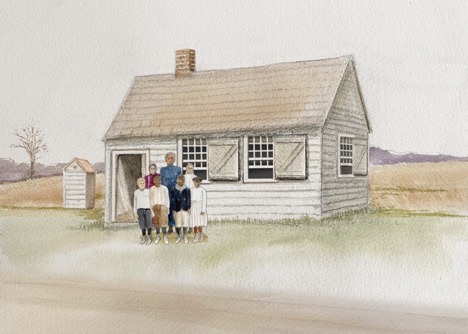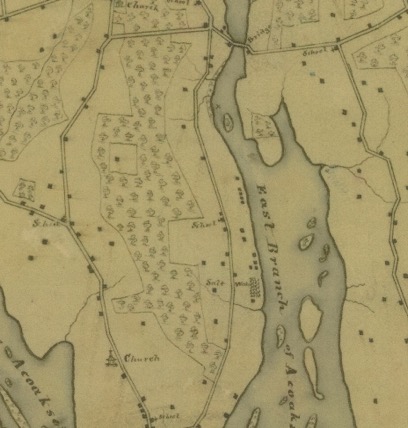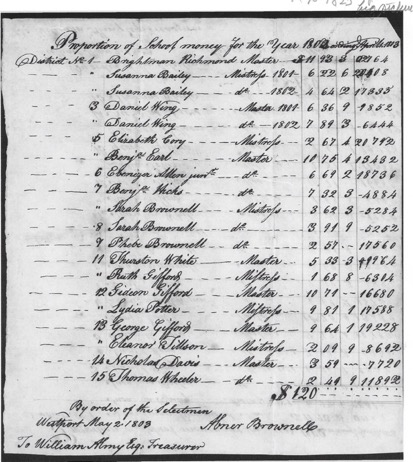For Black History Month, local historians Betty Slade and David Cole, delve further into the history of Paul Cuffe’s school, the first school in America open to people of all colors.
Introduction
Captain Paul Cuffe, son of an emancipated slave from West Africa and a native American woman, set up, with his own funds, a school in about 1797 near his home on what was known as Drift Way in Westport, Massachusetts. No public school existed in Westport at the time. “Cuff’s School” as it came to be known was open to boys and girls of all races. There is no evidence that any charge was made for attendance. It may well have been the first integrated and co-educational school in America. There is no evidence to refute that claim that we have found. This claim is repeated in the many volumes that have been written about Paul Cuffe. Articles about Cuffe during his life by his friends recall his story of that school and the importance that he placed on it. Cuffe deeply felt the disadvantages of lack of formal education and was determined to give opportunities to his children and the children of his friends and neighbors. It is clear from deed records at that time that Cuffe’s neighbors were mostly white and known to be mostly of the Quaker faith. It is also likely that Michael Wainer, a Native American originally named Micah Quabbin who was Cuffe’s long standing business partner, in-law, and friend, was living in the area and had 3 younger children at that time who could have attended. The London Richmond family (of color) were also nearby.
This paper provides some information on the location of Cuff’s School and on the early establishment of public schools in Westport.
Cuff’s School
In the memoir about Paul Cuffe that was first produced by members of the Delaware Abolitionist Society and based on conversations they had with Paul Cuffe while he was visiting Wilmington in 1807, the first references to Paul Cuffe’s school appear in the following passage:[1]
“Paul had experienced the many disadvantages of his very limited education, and he resolved, as far as it was practicable, to relieve his children from similar embarrassments. The neighborhood had neither a tutor nor a schoolhouse. Many of the citizens were desirous that a school should be established. Paul proposed a meeting of the inhabitants for the purpose of making such arrangements as should accomplish the desired object. The collision of opinion respecting mode and place occasioned the meeting to separate without arriving at any conclusion; several meetings of the same nature were called, but all were unsuccessful in their issue. Perceiving that all efforts to procure a union of sentiment were fruitless, Paul set himself to work in earnest, and had a suitable house built on his own ground. A master was procured, and the school open to all who pleased to send their children. Paul’s money paid for the house, but he never demanded rent for it, nor endeavoured to obtain any extraordinary authority in the control or regulation of the school.”

Painting of how Cuff’s School might have looked by Ray Shaw
Location of the School
The passage from the Paul Cuffe memoir says that Cuffe stated that his school was built on his “own ground.” Paul Cuffe had purchased a 0.22-acre property from Isaac Soule in 1789 which became Cuffe’s homestead. He built his house and large barn on this property.[2]His wharf was at the riverside of that property and is where he built his ships. It was on the river front on the southeast corner of Isaac Soule’s 66-acre homestead. Paul Cuffe was granted access to his property via a laneway running along the southern property line from the Drift Way (Drift Road) to the Cuffe property. By 1797 it is most likely that Cuffe rented the land around his house from the Sowle family. He eventually bought that land. It is possible the schoolhouse stood somewhere on that land or near to it.[3]
Isaac Soule died in 1791and his homestead was divided among his widow and four children. His son, David Soule, inherited fourteen acres, which he held for nineteen years before selling it as three separate pieces to Paul Cuffe (four-plus acres), Luthan Tripp (two acres) and Christopher Russell (seven acres). All three of these transactions were signed within one month, March 13 to April 13, 1813.
Maps of Westport from 1831, 1851,1858 and 1871 all show a school at a location between the current properties at 1393 and 1415 on the west side of Drift Road. Earlier deeds for these properties mention a schoolhouse along the road at the northeast and southeast corners of these properties. In 1797 these properties were still owned by David Soule. It seems possible and perhaps even probable that all these references are to the school that Paul Cuffe built in 1797 on land then belonging to David Soule and approximately 300 feet north of the northern boundary of Paul Cuffe’s eventual homestead.
On the 1831 map of Westport there are 10 schools scattered throughout the town from north to south. The segment of that map shown below indicates that there was a school on the Drift Way that would have been consistent with the location suggested above.

Section of Map of Westport, 1831
Early School Legislation in Massachusetts
When John Adams drafted the Massachusetts Constitution in 1780, he included provisions that guaranteed public education to all citizens. In 1789 Massachusetts was the first state in the nation to pass a comprehensive education law. In updating the colony’s 1647 law, the legislature required all teachers in grammar schools to “provide satisfactory evidence” that they had received a formal education in a college or university and, equally important, were of good moral character. The law began as follows:
“Be it enacted by the Senate and House of Representatives in General Court assembled & by the authority of the same, that every town or district within this Commonwealth containing fifty families, or householders, shall be provided with a Schoolmaster, or Schoolmasters of good morals, to teach children, to read & write, & to instruct them in the English language, as well as in arithmetic, orthography, and decent behaviour, for such term of time as shall be equivalent to six months, for one school in each year.”
Westport’s Response
The Town of Westport, established as an entity separate from the Town of Dartmouth in 1787, was slow to respond to this legislation. The first mention of provision for schooling is in the agenda for a Town Meeting in 1799, a decade after the State Law was enacted, where it appears as Item 4.
“To conclude what method to proceed in the year ensuing in regard to a Town School or Schools.”
The record of that 1799 meeting contains the following statement:
“Voted, That the Selectmen be directed to hire a School Supt the year ensuing agreeable to law, and that districting the town & the times and manner of keeping the school be left to the discretion of the Selectmen.”
The Town Meeting of 1800 contains the same agenda item and record of a vote with no provision for funding.
Finally in 1801 the Town Meeting voted some funding for schooling as the following record indicates:
“Voted that the sum of one hundred and twenty dollars of the sum voted for Town expenses be appropriated to the support of the schools in the way and manner the Selectmen shall direct in a way agreeable to law.
Voted the school districts, when they are found to be not convenient as they now are fixed, may be altered by the Selectmen, they to make report of their doings to the next meeting.
Voted that those school districts that do not make return to the Selectmen of the schooling within their district by the first day of April annually shall be excluded from having any part of the sum voted to be appropriated for schooling.”
The image below from the Town records shows how this sum of $120 was spent to compensate 17 teachers in 9 school districts in Westport in 1801-02. Daniel Wing in district 3 received the highest compensation of $14.25, followed by Richard Brightman and Susanna Bailey in district 1, Benjamin Earl and Gideon Gifford who all received more than $10 for the school year. Given the fact that all these teachers’ salaries added up to exactly $120 causes one to wonder whether the teachers had actual specified salaries or whether they were like shareholders on a whaling ship who were compensated according to their predetermined shares of the total.

Westport Teachers’ Salaries for 1801-02
Source: Westport Town Website, Historical Documents, 1790-1825 Financial-Reports Big-Picture
David Cole and Betty Slade
[1]“Memoirs of the Life of Paul Cuffee, the Interesting Negro Navigator” The Belfast Monthly Magazine.Vol. 7, No. 39 (Oct. 31, 1811). Pp. 284-292. First published by the Delaware Society for the Abolition of Slavery. URL: http://www.jstor.org/stable/30074388
[2]The 1798 Survey confirmed that Cuffe had a house and outbuilding in this area which were of considerable value.
[3]Paul Cuffe bought the Eddy land in 1799 and sold it to Michael Wainer in 1800 at which time Michael was already living in the house on that land with his family. Such accommodations were not unusual.